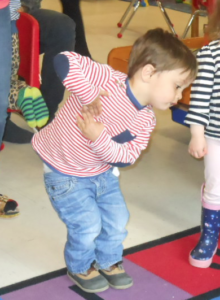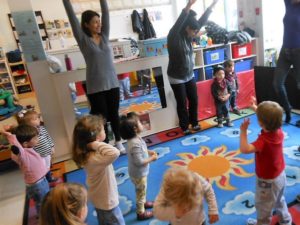 Did you know that children who aren’t active enough are at a higher risk of developing chronic diseases like type 2 diabetes, high blood pressure, high cholesterol, and other cardiovascular illnesses? On the other hand, adequate levels (60 minutes/day) of physical activity helps children:
Did you know that children who aren’t active enough are at a higher risk of developing chronic diseases like type 2 diabetes, high blood pressure, high cholesterol, and other cardiovascular illnesses? On the other hand, adequate levels (60 minutes/day) of physical activity helps children:
- develop cardiovascular fitness, strength, flexibility, and bone density
- maintain a healthy body weight
- reduce the risk of chronic disease and health problems
- lessen the likelihood of tobacco, alcohol, and drug use
- feel better every day, through improved mental health and well-being
 In 2013, only 1 in 10 children in Canada met the Canadian Physical Activity Guidelines, so efforts are being made across the country to support children and their families in making physical activity a regular part of their daily living. Making regular physical activity a habit at an early age will provide your child with lifelong benefits. Adults with higher levels of activity are able to carry out their daily tasks more easily and with less fatigue and, later in life, enjoy lower rates of bone loss associated with osteoporosis while also maintaining strength, flexibility, balance, and coordination.
In 2013, only 1 in 10 children in Canada met the Canadian Physical Activity Guidelines, so efforts are being made across the country to support children and their families in making physical activity a regular part of their daily living. Making regular physical activity a habit at an early age will provide your child with lifelong benefits. Adults with higher levels of activity are able to carry out their daily tasks more easily and with less fatigue and, later in life, enjoy lower rates of bone loss associated with osteoporosis while also maintaining strength, flexibility, balance, and coordination.
What Can You Do to Help?
 As childcare providers, caregivers, and parents, we all play an important role in the development of good health habits in children. Children under the age of six are constantly learning by copying what they see and hear, being more likely to develop healthy attitudes and adopt healthy behaviours when they see and hear positive health habits at home, at childcare and at school.
As childcare providers, caregivers, and parents, we all play an important role in the development of good health habits in children. Children under the age of six are constantly learning by copying what they see and hear, being more likely to develop healthy attitudes and adopt healthy behaviours when they see and hear positive health habits at home, at childcare and at school.
Here are a few tips to help teach children the importance of daily physical activity:
- Encourage – gently encourage them to walk or ride their bikes
- Schedule – be sure there is active time scheduled each day
- Mix it up – intersperse periods of moderate activity (e.g., walking or biking) with periods of more vigorous activity (e.g., running or or tag)
- Register – check with the Fun Guide, local schools and community centres for affordable programs (e.g., swimming, soccer, gymnastics)
- Unstructured Activity – For children who shy away from competition, build in physical activities that are informal and unstructured (e.g., tag)
- Mimicry – children under the age of six are constantly learning by copying what they see and hear, so set a positive example by being physically active as a family.
- Praise – remember to praise your children for being active. Confidence is the key to success!
- Share – reinforce positive health messages with other parents and caregivers, with information about physical activity, healthy eating and self-esteem
- Let us Help! At Creating Together, we apply the City of Toronto’s Rainbow Fun Guide in our programming – a physical activity and healthy eating program for children 3-6 years old. Through this program, children build on skills like listening, singing, movement and participation, while developing their fine and gross motor skills. Keep your eye out in our calendar for the busy body exercise cards, parachute play, and scarf dancing.

Other Resources:
- Handbook for Canada’s Physical Activity Guide to Healthy Active Living –
- Fitness Tax Credit – Allows parents to claim up to $500 a year for each child under 16 years of age or under 18 years of age if eligible for the disability tax credit, at the beginning of the year in which an eligible fitness expense was paid.
- Towards a Healthier Canada – 2015 Progress report on advancing the federal / provincial / territorial framework on healthy weights.
